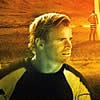Riding Giants (Stacey Peralta, 2004)
Stacey Peralta, known for his documentary on skateboarding, Dogtown & Z-Boys, takes us into the real history of surfing, from it’s Polynesian and Hawaiian roots to when Gidget’s cheeky sitcom in 1966 took surfing into the mainstream, raising the number of surfers from a few thousand to a few million within a few years, and starting a rage of beach and surfer movies considered to be a bad joke by the surfing community.
But Peralta takes it one step further. The progression of how each new territory was discovered is laid out before us on the big screen; how the massive, blue waves go from 30 feet to 50 feet, and how these mere surfers figure out how to ride those giants.
We get to hear from the greats like Greg Noll, known as “The Bull,” who made surfing history in the ’50s and ’60s with his attack on the big waves of Hawaii and the birth of surfing as a business, Jeffrey Clark who for 15 years was alone when riding some of the biggest waves in California at Mavericks near San Francisco, and Laird Hamilton, who reinvented the sport when he brought a jet ski and a newly designed board to create tow-in surfing. We hear form the horse’s mouth about the life they’ve led thanks to surfing, and most importantly, what makes them tick. The adrenaline rush pours out of their ears as they take on higher and higher waves, complete concentration is taken to ride every wave, and there’s a realization that this sport, this lifestyle could ultimately lead to their death.
This is what seems to separate surfers from many sports or pastimes. Maybe it is their element of choice. The ocean has always had a mystique about it, a huge power that can crush houses and huge ships, overflowing with a level of unpredictability. And maybe that is what makes them come back for more: To be able to take on this beast and at the same time form a long-time love affair with a force of nature that returns the love through the sheer experience of riding waves.
I was always fascinated with the dedication some of the guys at my high school had when it came to surfing. I grew up about 35 minutes north of Santa Cruz, and never having been a morning person, I was puzzled at the hour at which these surfers would rise in order to drive over the hill, get in some waves, then drive back to school in order to barely make it to class on time. They seemed to have this dedication not seen by others my age, along with an air of aloofness. It wasn’t an attitude, but a freedom from caring about getting the coolest car, who is dating who, or even dating at all. Granted, they had no problem getting girls and often did. But after seeing this movie it was crystal clear what the real love of their life was: the ocean waves. They were the equivalent of a woman. That’s where their passion led them.
It’s fascinating to watch the life these pioneers from Hawaii led, living in the North shores with nothing more than their boards, a few pairs of shorts, and themselves. For a few years these guys lived in Never Never Land without a care in the world, basically living off the land. Surfing all day every day, and then going fishing for lobster in the sea and climbing for coconuts in the trees. They didn’t have all the burdens of modern day life: money, career, kids, money, work, stress, boredom, money, anger. You get jealous just watching them.
It’s also overwhelming to realize just how much was at risk every time they went out. Peralta uses a mixture of 3-D photographs to bring you into the wave itself and a series of moving drawings that show just how tossed around these surfers get when they crash. Surfers from Mavericks and other big wave riders express that in order to survive they have to escape from their own minds to make the wave. Knowing what they knew about the ocean, the task at hand was daunting, if not impossible, but one they had to overcome. There just wasn’t any question about it.
This is a captivating and entertaining movie that pulls at every emotion, from the comedic way that Hollywood portrays this life, to the inspiring tales of these riders, to the loss involved when one of their soldiers fall. This is a call of the ocean of a different kind, as they sail the seas on a plank built for one.
Coming to Landmark Theaters www.landmarktheater.com

